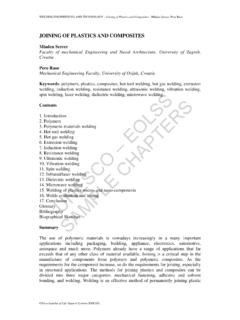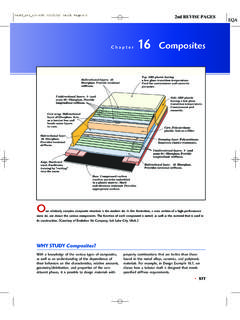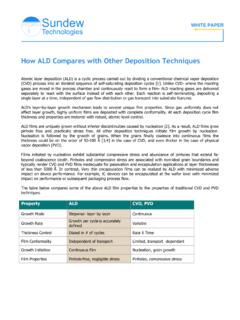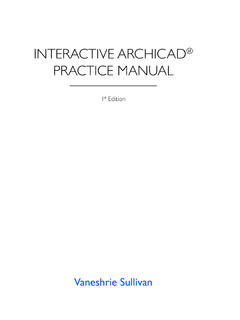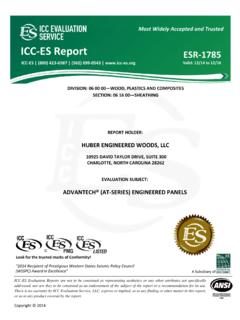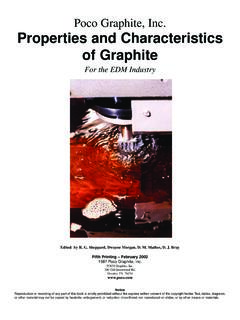Transcription of Introduction to Structural Health Monitoring - ISTE
1 chapter 1 Introduction to Structural Health Monitoring Definition of Structural Health Monitoring Structural Health Monitoring (SHM) aims to give, at every moment during the life of a structure, a diagnosis of the state of the constituent materials, of the different parts, and of the full assembly of these parts constituting the structure as a whole. The state of the structure must remain in the domain specified in the design, although this can be altered by normal aging due to usage, by the action of the environment, and by accidental events. Thanks to the time-dimension of Monitoring , which makes it possible to consider the full history database of the structure, and with the help of Usage Monitoring , it can also provide a prognosis (evolution of damage, residual life, etc.)
2 If we consider only the first function, the diagnosis, we could estimate that Structural Health Monitoring is a new and improved way to make a Non-Destructive Evaluation. This is partially true, but SHM is much more. It involves the integration of sensors, possibly smart materials, data transmission, computational power, and processing ability inside the structures. It makes it possible to reconsider the design of the structure and the full management of the structure itself and of the structure considered as a part of wider systems. This is schematically presented in Figure chapter written by Daniel BALAGEAS. 14 Structural Health Monitoring DiagnosisStructuralHealthMonitoringHealt h Managementof the structureHealth Managementof the full system(fleet, )Maintenance organizationMonitoredstructureMonitored physicalphenomenon, depending onthedamageIntegrity Monitoring system,defined by a sensed physicalphenomenon and an adapteddata reductionSensorsmultiplexingand networkingSensorsfusionMonitoring of usage conditionsHealth and UsageMonitoringPrognosisUsageMonitoringD ata cumulativerecordingDamage andbehavior lawsDamage Figure Principle and organization of a SHM system In Figure , the organization of a typical SHM system is given in detail.
3 The first part of the system, which corresponds to the Structural integrity Monitoring function, can be defined by: i) the type of physical phenomenon, closely related to the damage, which is monitored by the sensor, ii) the type of physical phenomenon that is used by the sensor to produce a signal (generally electric) sent to the acquisition and storage sub-system. Several sensors of the same type, constituting a network, can be multiplexed and their data merged with those from other types of sensors. Possibly, other sensors, Monitoring the environmental conditions, make it possible to perform the usage Monitoring function. The signal delivered by the integrity Monitoring sub-system, in parallel with the previously registered data, is used by the controller to create a diagnostic.
4 Mixing the information of the integrity Monitoring sub-system with that of the usage Monitoring sub-system and with the knowledge based on damage mechanics and behavior laws makes it possible to determine the prognosis (residual life) and the Health management of the structure (organization of maintenance, repair operations, etc.). Finally, similar structure management systems related to other structures which constitute a type of super system (a fleet of aircraft, a group of power stations, etc.) make possible the Health management of the super system. Of course, workable systems can be set up even if they are not as comprehensive as described here. Introduction to SHM 15 Motivation for Structural Health Monitoring Knowing the integrity of in-service structures on a continuous real-time basis is a very important objective for manufacturers, end-users and maintenance teams.
5 In effect, SHM: allows an optimal use of the structure, a minimized downtime, and the avoidance of catastrophic failures, gives the constructor an improvement in his products, drastically changes the work organization of maintenance services: i) by aiming to replace scheduled and periodic maintenance inspection with performance-based (or condition-based) maintenance (long term) or at least (short term) by reducing the present maintenance labor, in particular by avoiding dismounting parts where there is no hidden defect; ii) by drastically minimizing the human involvement, and consequently reducing labor, downtime and human errors, and thus improving safety and reliability. These drastic changes in maintenance philosophy are described in several recent papers, in particular for military air vehicles [DER 03], for Army systems [WAL 03] for civil aircraft [BER 03, GOG 03], and for civil infrastructures [FRA 03].
6 The improvement of safety seems to be a strong motivation, in particular after some spectacular accidents due to: i) unsatisfactory maintenance, for example, in the aeronautic field, the accident of Aloha Airlines [OTT 88] see Figure ) or, in the civil engineering field, the collapse of the Mianus River bridge; ii) ill-controlled manufacturing process, for example, the Injak bridge collapse (see Figure )). In both fields the problem of aging structures was discovered and subsequent programs were established. To pinpoint the importance of the problem of Structural aging, the following statistic can be recalled: bridge inspection during the late 1980s revealed that on the 576,000 US highway bridges, 236,000 were rated deficient by present day standards [WAN 97].
7 Nevertheless, analysis of the various causes of aircraft accidents points to the relatively low influence of maintenance deficiency. Figure shows that maintenance is only responsible of 14% of hull loss. Furthermore, it should be noted that only 4% of all accidents are due to Structural weakness. It can be concluded that, thanks to the Introduction of SHM, even an improvement in maintenance and a decrease of structure-caused accidents by a factor of two would lead to a global reduction of accidents of less than 10%, which is far from what is needed to avoid a significant increase in the number of accidents in the near future if air traffic continues to increase. The economic motivation is stronger, principally for end-users.
8 In effect, for structures with SHM systems, the envisaged benefits are constant maintenance costs and reliability, instead of increasing maintenance costs and decreasing reliability for classical structures without SHM (see Figure ). 16 Structural Health Monitoring a) b) Figure Spectacular accidents have motivated the community to improve safety: a) the Aloha Airlines flight 243, April 29, 1988, due to corrosion insufficiently controlled by maintenance; b) the Injaka bridge collapse, July 1998, due to a poorly controlled construction process Introduction to SHM 17 Figure Origin of hull losses: safety record for the worldwide commercial jet fleet, from [GOR 97] Structure LifetimeStructure QualityReliabilityCost of maintenanceStructure without SHMS tructure with SHM Figure Benefit of SHM for end-users [CHA 02] The economic impact of the Introduction of SHM for aircraft is not easy to evaluate.
9 It depends on the usage conditions and, furthermore, it is difficult to appreciate the impact on the fabrication cost of the structure. The cost of SHM systems must not be so high as to cancel out the expected maintenance cost savings. 18 Structural Health Monitoring It is easier to evaluate the time saved by the new type of maintenance based on the Introduction of SHM. Such an evaluation can be found, for military aircraft, in [BAR 97], who reports that, for a modern fighter aircraft featuring both metal and composite structure, an estimated 40% or more can be saved on inspection time through the use of smart Monitoring systems. Table presents the figures resulting from this evaluation. Inspection type Current inspection time (% of total) Estimated potential for smart systems Time saved (% of total) Flight line 16 Scheduled 31 Unscheduled 16 Service instructions 37 100 Table Estimated time saved on inspection operations by the use of SHM, for modern fighter aircraft, from [BAR 97] Still in the aeronautic domain, there is also a benefit for constructors.
10 Taking into account the permanent presence of sensors at the design stage will permit a reduction in the safety margins in some critical areas. Weight reduction will be then possible, giving higher aircraft performance, lower fuel consumption and greater maximum range. Structural Health Monitoring as a way of making materials and structures smart Since the end of the 1980s, the concept of smart or intelligent materials and structures has become more and more present in the minds of engineers. These new ideas were particularly welcome in the fields of aerospace and civil engineering. In fact, the concept is presently one of the driving forces for innovation in all domains. The concept of Smart Materials/Structures (SMS) can be considered as a step in the general evolution of man-made objects as shown in Figure There is a continuous trend from simple to complex in human production, starting from the use of homogeneous materials, supplied by nature and accepted with their natural properties, followed by multi-materials (in particular, composite materials) allowing us Introduction to SHM 19 to create structures with properties adapted to specific uses.
